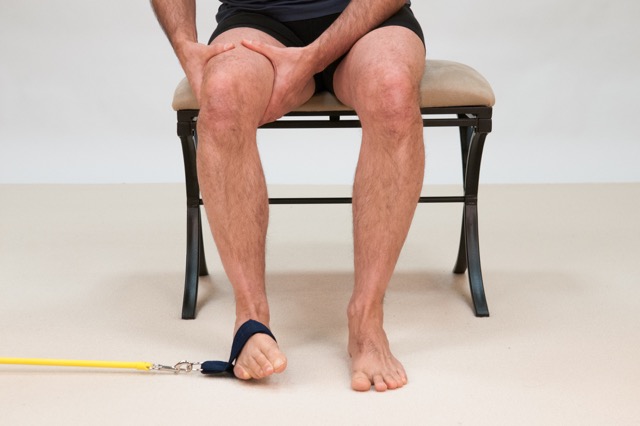Self-care for the client/patient:
When working with a client/patient for the treatment of overpronation of the foot, the importance of client self-care is extremely important. Supple flat foot is essentially a condition of weakness of the ligament complex and musculature that supports the arch. Therefore, strengthening the weak musculature is imperative if the condition is to be resolved. The specific musculature that should be assessed and strengthened if weak was given in another blog article on this condition. The challenge is that this musculature must be strengthened to the point that it can do its job, but also compensate for the weakened ligament complex. If this is possible, it will require dedication on the part of the client. The major muscle groups to strengthen are the supinators (invertors) of the foot and the lateral rotators and abductors of the thigh at the hip joint.

Thera tubing self-care exercise for the inverters (supinators) of the foot. Permission: Joseph E. Muscolino.
One very easy, inexpensive, and low-tech way to accomplish home-care strengthening is by using elastic (thera)tubing or bands to perform the exercise. The tube/band is held in place by a closed door; and altering the distance from the door, thereby lengthening or slackening the tube/band, can easily vary the tension. As a general rule, these exercises should be performed in four phases. Phase one involves performing the exercises slowly through a short range of motion, whereas phase two involves moving through the same short range of motion, but quickly. Phase three is performed slowly through a large range of motion; and phase four is performed by moving quickly through a large range of motion. Begin by performing each exercise for approximately 15-30 seconds, gradually working toward 60 seconds. Once each phase can be comfortably and proficiently performed, direct the client to transition to the next phase. Each phase usually takes approximately 2-4 weeks (but ultimately the amount of time needed is determined by the particular needs of that client). Once all four phases have been mastered, your client/patient can begin again, this time with greater resistance.
An excellent self-care exercise for the intrinsic plantar musculature of the foot is to be seated with a towel placed in front of you on a hardwood, tile, or linoleum floor. Bare-footed, flex your toes, scrunching up and drawing toward you the towel; then release the towel and extend your toes back to starting position. Repeat this until the entire towel has been drawn toward you. Repeat as desired. Another simple self-care strengthening exercise for the intrinsic musculature of the foot is to practice picking up marbles with your toes.
Finally, it is important to discuss with the client postures to be avoided, proper shoes or orthotics to wear, and the possibility of losing weight if the client/patient is overweight. If you are schooled in orthopedic taping, this modality can be valuable. The importance of taping is not to temporarily support the arch, but rather to help the client’s/patient’s nervous system receive proper proprioceptive feedback so that it can hopefully learn the proper posture/acture between pronation and supination.
Note about minimalist shoes:
There is a philosophy that we should not wear shoes or that we should wear the least footwear, in other minimalist shoes, as possible. After all, we were evolved to walk barefoot on the feet that nature has given us. Therefore, any changes in mechanics that shoes create are likely to be negative. For example, most all shoes, especially stiff ones, do not ask our toes to work to grab the ground. Therefore, most all of our intrinsic foot musculature and some of our extrinsic foot musculature will not be exercised and will consequently weaken, offering less support to our arch structure. For these reasons, many people recommend minimalist shoes. Excepting people with a genetic anomaly and/or an injury that would require shoes to be worn, this logic seems valid. However, if a client/patient has been wearing shoes with arch support for 20, 30, or 50 years, and you recommend that they suddenly throw them away and go running barefoot or in minimalist shoewear, they risk a physical stress level demand upon their feet (and indeed the entire lower extremity and perhaps spine) that might overwhelm their structure and result in injury. Any change asked of the body should be done in a gradual and incremental manner. If a client wants to transition toward minimalist shoes, this transition should be done over weeks or months.
Medical approach:
Overpronation is a postural dysfunctional pattern; therefore there really is no “medical” approach. If a podiatrist is consulted, it is likely that orthotics to support the client’s/patient’s arches and control excessive pronation will be recommended. Generally, orthotics can be divided into two categories: soft and rigid. Rigid orthotics better control the foot motion, but do not provide shock absorption for the joints of the lower extremity and spine; whereas soft orthotics provide excellent shock absorption but do not control the pronation as well. The best orthotic to use will vary from person to person. There is also the choice of custom made/fitted orthotics that can easily cost many hundreds of dollars, versus premade store-bought orthotics that cost far less. Custom fitted orthotics are superior, but their cost may be prohibitive for the client.
It should be stated that the decision to wear orthotics is a controversial one. Orthotics are a passive brace that do little or nothing to retrain the body to stop overpronating. In fact, it could be argued that they do harm in that they remove the need for the client’s/patient’s arch support musculature to contract, thereby causing them to further weaken. The same argument could be made for shoes with sturdy arch support. There is merit to this argument. However, if the client’s/patient’s musculature cannot be retrained, or the client/patient is simply not interested in attempting the retraining program, then a passive support is likely better than the effects of chronically overpronating.


